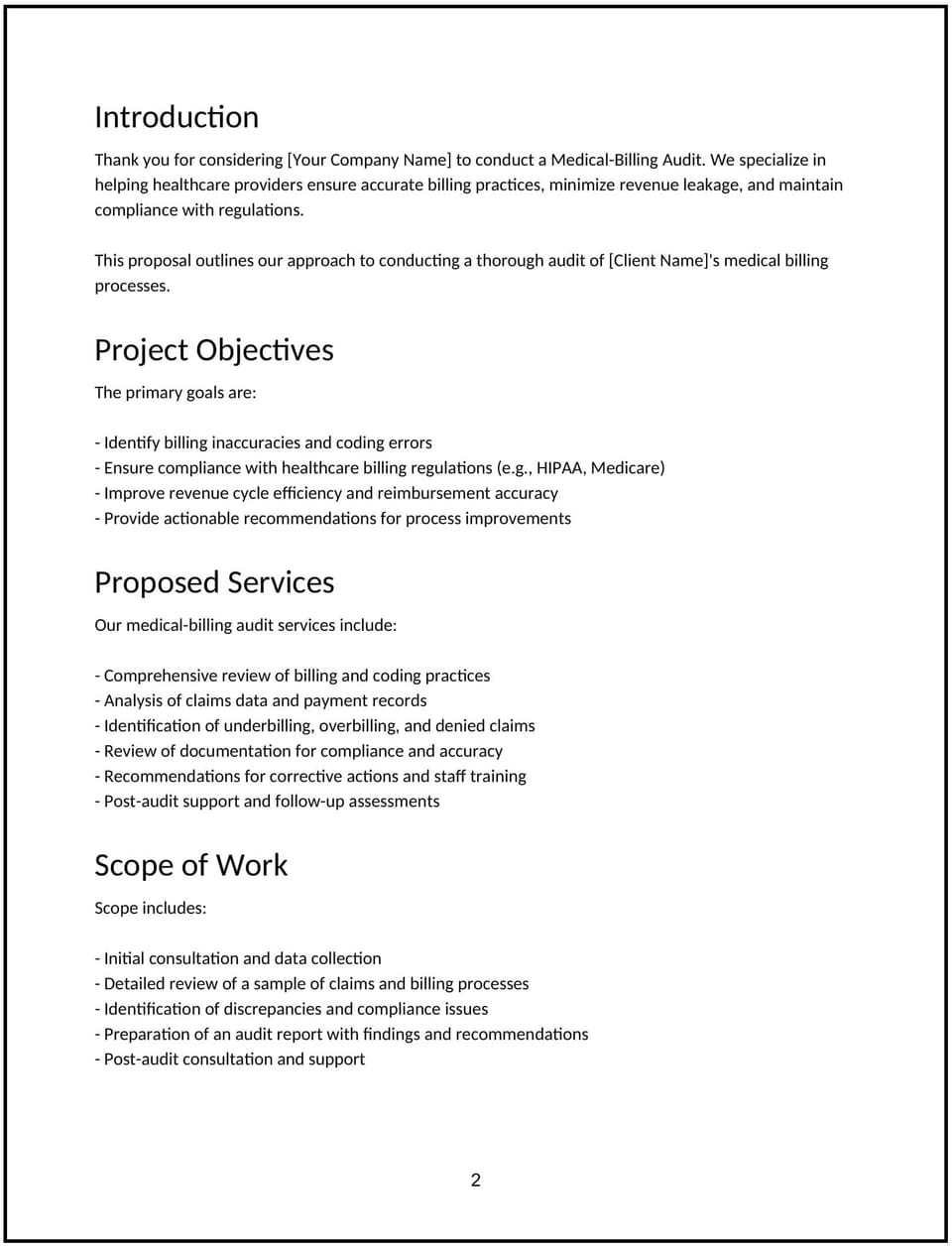Medical-billing audit proposal: Free template

Customize this free medical-billing audit proposal with Cobrief
Open this free medical-billing audit proposal in Cobrief and start editing it instantly using AI. You can adjust the tone, structure, and content based on the provider type, audit scope, and compliance goals. You can also use AI to review your draft — spot gaps, tighten language, and improve clarity before sending.
Once you're done, send, download, or save the proposal in one click — no formatting or setup required.
This template is fully customizable and built for real-world use — ideal for pitching billing audits to physician groups, clinics, hospitals, or third-party billing providers. Whether you're conducting a full revenue cycle audit or a targeted compliance review, this version gives you a structured head start and removes the guesswork.
What is a medical-billing audit proposal?
A medical-billing audit proposal outlines your plan to review and analyze a healthcare provider’s billing practices for accuracy, compliance, and efficiency. It typically includes the audit scope, process, sampling method, reporting format, and recommendations for improvement.
This type of proposal is commonly used:
- When a provider suspects revenue leakage, coding issues, or compliance risk
- After a payer denial spike or internal audit request
- To ensure documentation and coding align with CMS, CPT, and payer rules
It helps the client understand how their billing is performing, what’s at risk, and how to fix issues before they escalate.
A strong proposal helps you:
- Clarify the audit’s purpose and focus — revenue recovery, compliance, or both
- Set expectations around access, data, timeline, and follow-up
- Build trust by showing structure, credentials, and neutrality
- Position your findings as both corrective and strategic
Why use Cobrief to edit your proposal
Cobrief helps you produce a polished, audit-ready proposal in less time — with live editing and built-in AI support.
- Edit the proposal directly in your browser: No formatting tools required — just click and start working.
- Rewrite sections with AI: Instantly adjust tone, simplify technical explanations, or tailor the scope to the client’s specialty.
- Run a one-click AI review: Catch vague language, missing steps, or overcomplicated sections before sending.
- Apply AI suggestions instantly: Accept changes line by line or apply all edits across the document with one click.
- Share or export instantly: Send your proposal through Cobrief or download a clean PDF or DOCX version.
You’ll save time and build more trust with a clear, well-structured offer.
When to use this proposal
Use this medical-billing audit proposal when:
- Quoting an audit for a physician group, outpatient clinic, or hospital department
- Responding to compliance concerns or payer denials
- Reviewing a third-party billing vendor’s work
- Preparing for a Medicare, Medicaid, or private payer audit
- Identifying process gaps in charge capture, coding, or claims submission
It’s especially useful when providers need clarity and control over how billing affects cash flow and compliance risk.
What to include in a medical-billing audit proposal
Use this template to walk the client through your audit approach — from discovery to reporting — in plain-smart language.
- Project overview: Summarize why the audit is needed — such as denials, revenue concerns, or compliance risks — and what your review will cover.
- Audit scope: Define what will be reviewed — coding accuracy, modifier use, documentation alignment, charge capture, or billing workflows.
- Sampling method: Explain how you’ll select records — random, risk-based, stratified by payer, or date range.
- Review process: Describe how claims will be analyzed — against CPT/ICD/HCPCS codes, payer rules, and documentation standards.
- Reporting and insights: Clarify what the client will receive — audit findings, compliance risk areas, revenue recovery opportunities, and specific action steps.
- Timeline and access: Set expectations on duration, system access, and data required for review.
- Pricing: Present a clear pricing model — per chart, per provider, or flat audit fee. Note any optional services like re-audit or training.
- Next steps: End with a simple CTA — such as confirming scope, scheduling data access, or signing the service agreement.
How to write an effective medical-billing audit proposal
This proposal should feel credible, focused, and helpful — especially for clinical or operational leaders managing financial risk.
- Speak to both compliance and revenue: Show how the audit supports both risk reduction and better collections.
- Tailor to the specialty: Use audit examples and language that reflect the client’s procedures, codes, and payer mix.
- Clarify what’s included: Define the depth of the review and avoid scope creep by setting expectations upfront.
- Make reporting actionable: Frame the output as a practical roadmap — not just a list of errors.
- Reinforce your experience: Mention credentials like CPC, CPMA, or billing expertise if relevant.
- End with a step forward: Help the client take action without hesitation or confusion.
Frequently asked questions (FAQs)
Can I reuse this proposal for different specialties?
Yes — just update the audit scope, terminology, and examples to reflect the client’s practice area.
Does this include staff training?
Only if listed. You can offer training on documentation or coding as an optional service.
Can I audit a third-party billing company?
Yes — this proposal works for independent audits of outsourced billing providers or internal teams.
What kind of access do I need to perform the audit?
Usually EHR or billing system access and anonymized records. You can request this during kickoff.
Is this proposal a binding contract?
No — this outlines your scope, pricing, and plan. A separate agreement can be attached or signed as needed.
This article contains general legal information and does not contain legal advice. Cobrief is not a law firm or a substitute for an attorney or law firm. The law is complex and changes often. For legal advice, please ask a lawyer.